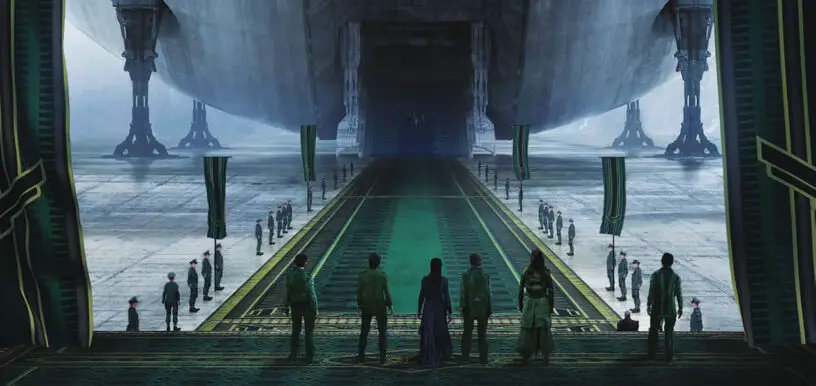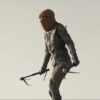Frank Herbert’s Dune has been adapted into a screenplay multiple times and most of these scripts contain several of the same key scenes from the novel; such as the Gom Jabbar, Paul’s training (normally with Gurney), the Hunter-Seeker, Spice mining inspection, and first sandworm ride. One area, however, which tends to differ greatly from the novel is how these movies begin.
In this article we’ll look at the multiple openings explored during development of 2021’s Dune: Part One movie, and how these compare to previous cinematic attempts to introduce audiences to the worlds of Dune.
A Test of Humanity or the Story of Creation?
The original novel opens with the Gom Jabbar test and, initially, Denis Villeneuve did try to start his movie adaptation’s script with that very scene. The director discovered that that this was throwing the audience in at the deep end.
Another attempted opening was a flashback centered on Jessica’s time training at the Bene Gesserit school:
Eric Roth had written a fantastic prologue that I deeply loved about the past of Lady Jessica, where we where seeing all her education, her skills, coming out of the Bene Gesserit school and I had to cut it out.
Denis Villeneuve – Hollywood Reporter
Script writer Eric Roth also tried another very different opening:
Because I’m adventurous, I started the movie with what would seem to be Genesis — ‘and God created’ — and you think you’re seeing the formation of the Earth. And it’s Dune, with wild animals, things you’ve never seen. Denis said, ‘This is magnificent, but now we can’t afford the rest of the movie.’ I don’t know if that was his way of saying, ‘I don’t want to do it!’
Eric Roth – IndieWire
In a script dated September 2018, around six months before filming began, the movie started with a narration by Reverend Mother Mohiam, describing the various factions in the Dune universe. This was not too dissimilar to the intent of Irulan’s introduction in David Lynch’s Dune (1984). It is unclear if Charlotte Rampling recorded any dialogue for this scene. Since no visual concepts have surfaced, this opening may have been discarded before any work began on it.
Free Falling to Arrakis
Following the narration, we would have seen Duncan Idaho jumping from a spaceship and landing on Arrakis – a scene also referred to as the “Duncan Drop”. This was certainly filmed, partly in Budapest, where a giant LED screen was created (similar to the technology use in The Mandalorian). This ensured that the reflections in Duncan’s visor could be captured in-camera. The second half was filmed in the Jordanian desert, with a giant crane lowering Jason Momoa’s stunt double, to recreate the low-suspensor slowness towards the end of free fall.

According to The Art and Soul of Dune, Villeneuve decided to cut the entire “Duncan Drop” sequence as it didn’t fit within the canon or style of the novel.
This omission created a number of issues. Without this introduction to Duncan’s character his reappearance later in the movie would be confusing, meaning it required a new scene to be filmed during additional photography.
Additional Photography
Additional photography, or reshoots as they are sometimes referred to, have been common in movies since the early days of Hollywood. Following the editing, or after an audience preview, the filmmakers may realize that some elements weren’t working well and either needed to be redone, or additional/replacement scenes filmed. Perhaps even just needing a shot of a character coming through a doorway, or adding a single line of dialogue that couldn’t be dubbed in. When actors worked under studio contracts this was easy to arrange, but these days additional photography will be part of individual film contracts with respective actors.
For Dune: Part One the COVID lockdown delayed the additional photography, and it wasn’t until August 2020 that actors returned to Budapest to film the new scenes.
Fremen Prologue
Rather than the film opening with narration by Mohiam, which was presented very much as exposition, it is instead Chani explaining the universe of Dune from the Fremen point of view. While the June 2020 script contains a description of the Fremen attack on the Spice harvester Chani’s prologue was still “TBD” (to be determined), suggesting it was one of the very last pieces of the script to be completed. The opening taking place on Arrakis also ensured the titular planet name appears right at the start. This was especially important as removal of the “Duncan Drop” would otherwise have left Arrakis offscreen for around 30 minutes.
Herald of the Change
After the prologue we have footage from the 2019 photography of Paul waking in his bedroom, but the breakfast scene with Jessica was filmed in 2020. This new scene shows us Jessica teaching Paul The Voice, allowing for a later training scene in Arrakeen to be removed. The breakfast dialogue also establishes that the Herald of the Change is arriving that day. The Herald is not a character that appears in the novel, but the scene clearly establishes the role the Emperor is playing in assigning Arrakis under the care of House Atreides.
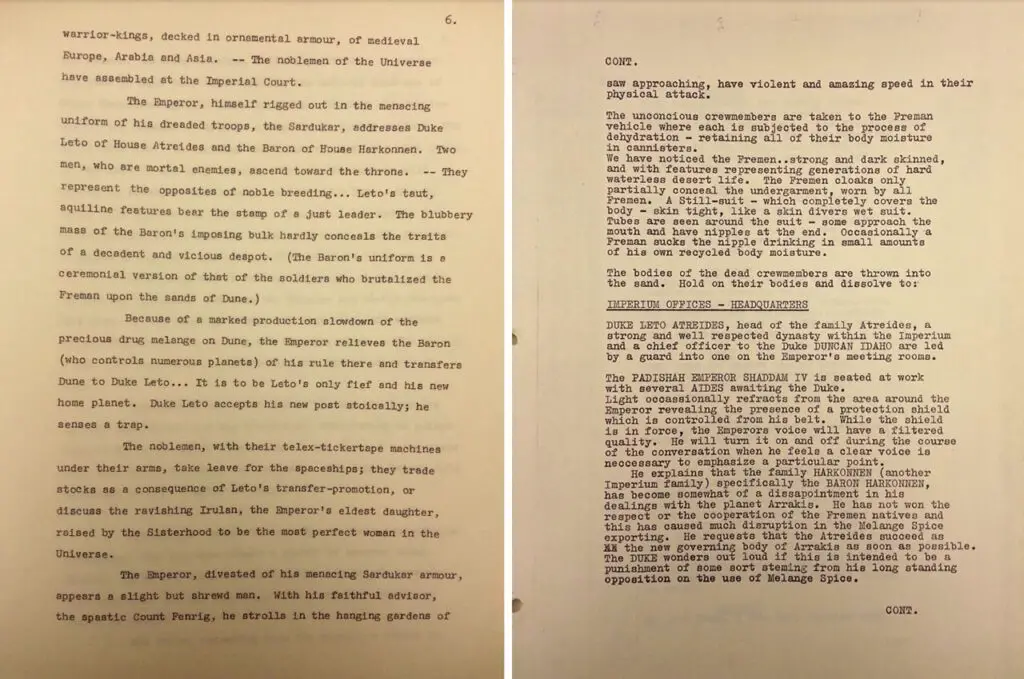
A curious commonality between the many Dune movie adaptations across the decades is a scene showing the Emperor transferring fiefdom of Arrakis from the Harkonnens to the Atreides. This normally appears within their first 10 pages, despite no such scene existing in the novel. Both of the Arthur P. Jacobs treatments contain such an event (see script pages above); Alejandro Jodorowsky’s Dune opens with the Atreides, Harkonnens, and the Emperor in the Imperial Senate; and of course Lynch’s Dune has the Emperor explaining his plan to the third stage Guild Navigator.
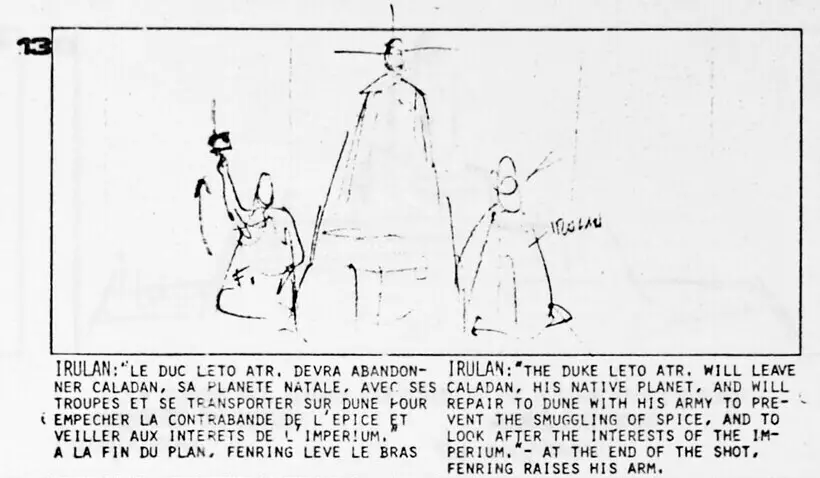
The same is true for Paramount’s Dune attempt; Josh Zetumer’s 2008 treatment for Peter Berg has “the official ceremony where the Emperor will hand Dune over to the Atreides family; it will also be the first time the Harkonnens and the Atreides have been in the same room together in years.” Chase Palmer’s 2010 script for Pierre Morel does at least wait until page 20 before the Emperor takes the Imperial seal of Arrakis from the Baron and hands it to the Atreides—with the Emperor’s dialogue being strangely similar to that of the Herald’s in Dune: Part One:
I entrust it to you Duke, witnessed this day, 10,191 A.G, by members of my royal court, the Spacing Guild, and the Landsraad High Council.
The Emperor – Chase Palmer’s Dune Script
We are witnessed by members of the imperial court, representatives of the Spacing Guild, and a sister of the Bene Gesserit.
Herald of the Change – Dune: Part One
Paul and Duncan
One of the additional scenes shot for Dune: Part One involved Paul talking to Duncan on Caladan. This resolved the issue of the missing introduction of Duncan from the cut “Duncan Drop”, however created another problem. Jason Momoa had shaved off his beard for the initial production in 2019, but he was unwilling to shave it off again in 2020. This meant that the film would go from a bearded Duncan on Caladan to a much shorter beard on Arrakis.

Fearing audiences would spot this continuity error, another new scene with Duncan was scripted to be filmed during the additional photography. During a farewell party for Duncan, in the Atreides officers’ mess on Caladan, the Duke decides that Duncan needs a trim before leaving for Arrakis. The scene ends with Leto advancing on Duncan, while both Gurney and Lanville pin the swordmaster down.
Duncan, you’re a fine fighting man. But you look like a barbarian. (he grins) Tonight, that beard comes off.
Leto – Dune: Part One Script
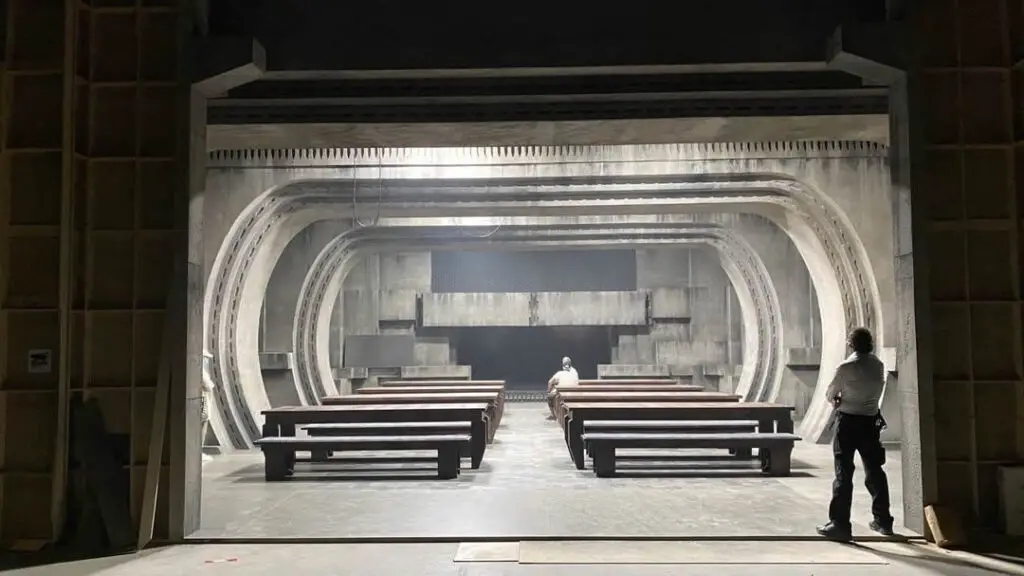
Ultimately it was realized that the film’s audience didn’t care about the beard—there was plenty of time for Duncan to have shaved in between the times we see him—and the scene was cut.
I did additional shooting at one point, for one scene, a moment, and it was not possible to shave him because of continuity. I was really p***** off, and it was out of the question that I would do CG to remove that. I was against the idea. Then we wrote the scene, to make jokes about the fact, and it felt so bad, so cheesy, that I decided to remove it. I said, ‘F*** it, we’ll embrace the fact that this character has a beard at the beginning and the end. Then he shaves when he goes in the mission, in the desert,’ and nobody noticed.
Denis Villeneuve – Directors UK
The Duke’s Beard
Beards also caused issues for new scenes with Duke Leto – but for the opposite reason. Oscar Isaac hadn’t had enough time to fully regrow his beard, so wig maker Kristy Staky created some beard extensions to match the look filmed in 2019.

Caladan Cemetery
An early version of the script had the cemetery on an island in the middle of a lake. Paul and Leto would swim there wearing “futuristic wetsuits.” Ultimately the swimming aspect was scrapped, but a cemetery scene was shot in 2019 in Budapest. All the dialogue, however, was later rewritten and re-shot in 2020.
All in all, almost the entirety of Dune: Part One‘s first 16 minutes, right up to Paul training with the dummies, were part of the additional photography.
Several of the scripts mentioned in this article—including the June 2020 “Final Shooting Draft” of Dune: Part One by Jon Spaihts, Denis Villeneuve, and Eric Roth—can be downloaded from the DuneInfo Script Archive.


